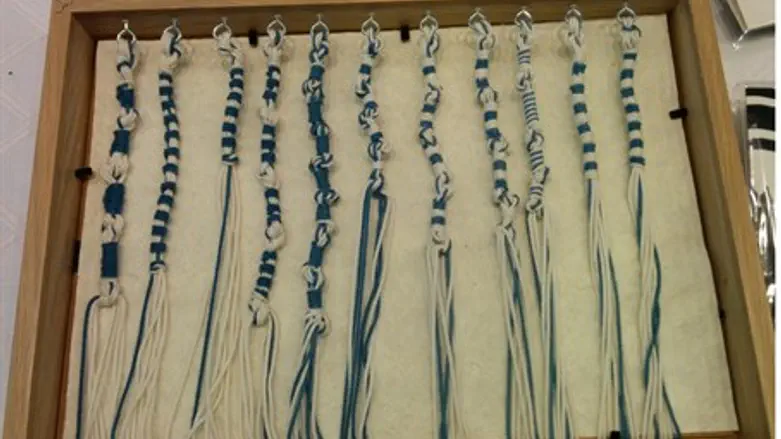
The Jewish commandment to tie tzitzit (fringes) to four-cornered garments, as a reminder of all the commandments, includes the precept to tie a thread dyed "tekhelet," a shade of sky-blue. The secret of this dye was lost for millennia - until recent discoveries that is, which may be reviving the ancient commandment.
Tekhelet dye was said to be created from a sea creature known as the hilazon. Traditions identifying the species were lost during the tumultuous exile following the destruction of the Second Temple, but in recent years researchers and some rabbis say archaeological discoveries have shed light on its identity: a sea snail called Murex Trunculus. As a result, today the tradition of tekhelet has seen something of a revival, with thousands of Jews wearing a blue thread on their tzitzit once more.
However, tzitzit are made of wool, which means decomposition renders the likelihood of finding direct scientific evidence of its use in tzitzit in the ancient world slim at best. As a result, not everyone is convinced, and most Jews still do not wear the tekhelet, But now, researchers say, they have found the proof they were looking for.
Ptil Tekhelet, an organization that has been leading research on the lost dye since 1991, held a "100 Years to Tekhelet Research" conference in Jerusalem on Monday, honoring the anniversary of Chief Rabbi Isaac Herzog's doctoral dissertation, The Dyeing of Purple in Ancient Israel.
The day-long conference, which attracted roughly 350 participants, featured lectures by scientists, researchers and rabbinic scholars, and allowed participants to purchase tekhelet-dyed tzitzit from the organization.
Recent efforts to rediscover the tekhelet dye were pioneered by Rabbi Gershon Henoch Leiner, the Radziner Rebbe, who researched the subject in 1887 and later by Chief Rabbi Herzog. Rabbi Herzog's grandson, recently elected Labor party chairman MK Yitzchak Herzog, who earlier this month spoke of his vision of dividing Jerusalem and withdrawing from large portions of Judea and Samaria, also was in attendance.
New discovery -- the first tekhelet dyed fabric in Israel
At the conference Dr. Na'ama Sukenik of the Israel Antiquities Authority presented her research on recently analyzed 2,000 year old fabrics that were found in the Murabba'at caves in the Judean desert.
Among the fabrics is what Sukenik reports to be the first tekhelet dyed fragment in Israel. The findings strengthen early research positing that the hilazon snail is in fact the murex snail, according to its current scientific name.
“Until now, our most important discovery had been the piles and piles of murex trunculus (hillazon snail) shells from the area, which served as a silent testimony to the presence of an ancient dyeing industry in Israel," said Sukenik at the conference.
The most recent find is definitive proof of both a colored fabrics trade and strict adherence to the commandment of tekhelet in ancient Israel, according to Sukenik.
In her research, Sukenik was assisted by Dr. Alexander Varvak and Dr. Orit Shamir in examining the artifacts using advanced analytical instrumentation for identifying dye substances (HPLC).
One wool fabric artifact was apparently dyed with murex snail secretions and then exposed to sunlight or heat, a method which achieves a shade of blue thought to be the traditional tekhelet. There are practically no parallels for this discovery in the archaeological record, making the find extremely rare.
Religious implications of a newly revived commandment
In addition to scientists and archaeologists, several rabbis spoke at the event about the tekhelet commandment.
"We live in a time of the redemption, and our reaction to (the new findings) should be to elevate ourselves to the most angelic and sublime form," said Rabbi Dr. Tzvi Hirsch Weinreb, Executive Vice President Emeritus of the Orthodox Union. "We should see the fulfillment of the commandment of tekhelet, the mitzvah that is at the root of our being, as an integral part of that process."
Rabbi Dr. Meir Soloveichik, Rabbi of Congregation Shearith Israel, NY, and Director of Yeshiva University's Straus Center for Torah and Western Thought, closed the conference by speaking about the symbolism of tekhelet.
"While the white strings represent that which we can simply understand, the tekhelet represents the mysterious and the limits of human understanding," commented Rabbi Soloveichik. "For centuries, Jews wore purely white tzitzit. A Jew can fulfill the mitzvah with only white fringes, but only when the concrete and the mysterious are on display side by side are Torah and Judaism truly represented."
Rabbi Soloveichik further tied the symbolism to the national identity of Israel.
"The union of blue and white fulfills a commandment as well as the dream of Zionism itself," remarked Rabbi Soloveichik. "Israel is simultaneously a modern democratic marvel and a symbol of the Jewish people as the Chosen People. This conference is not only a celebration of a scientific discovery and the furthering of Jewish Law, but an opportunity to ponder the symbolism of this combination and recognize our place in the enduring Jewish story
Participants at the event expressed appreciation for the analysis of both the scientific and religious aspects of tekhelet, noting that the panel of rabbis discussing the renewal of the commandments was impressive.
While the newly rediscovered dye has not been taken on by all Jews yet, participants noted rabbis at the event expressed approval, even if they don't all encourage the dye as an obligation at this time, signifying how the commandment may be reinvigorated by the people from the ground up.


